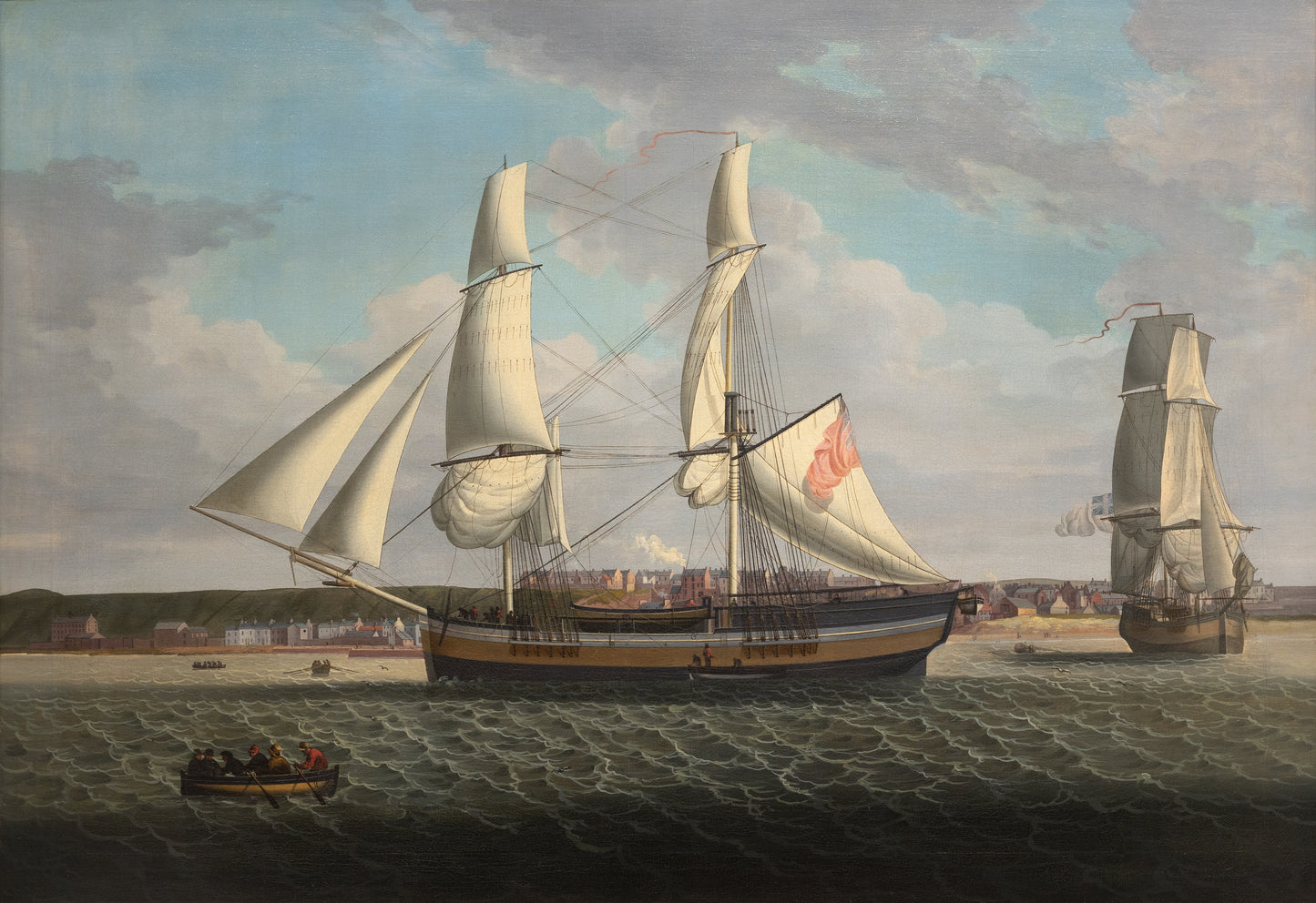from: Marine
Robert Salmon. A Departing Brig Off Maryport Harbor.
Robert Salmon. A Departing Brig Off Maryport Harbor.
Couldn't load pickup availability
Robert Salmon (Scottish American, 1775-1848)
A Departing Brig Off Maryport Harbor
Oil on canvas
31 ¼” x 45”
Provenance: Vose Galleries, Boston, Massachusetts. Private collection, New England.
Christie's, New York, 16 March 1995, lot 16, sold by the above.
Private collection, Newton, Connecticut, acquired from the above.
Private collection, Palm Beach, Florida.
Barridoff Auctions, Portland, Maine, 6 August 2004, lot 48, sold for $138,000.
Quester Gallery, Greenwich, Connecticut.
Acquired by private collector from above, 2005.
Robert Salmon was both an exceptionally fine artist and one of historical significance in the history of American art. He was only the second professional marine specialist to work in the United States-Thomas Birch, in Philadelphia, preceded him-and the first in New England. Thus, Salmon represents the beginning of a vital artistic tradition which would include Fitz Henry Lane at mid-century, and Winslow Homer in the last decades of the nineteenth century.
Like Birch, Salmon was born in England, but unlike the former, whose father, William, was a noted artist in his native land, Thomas Birch developed his art in the new American republic. Salmon was a well-established marine painter in both England and Scotland before he immigrated to the United States in 1828. Thus, he was very much a part of the impressive tradition of marine painting in Great Britain that began as early as 1673 when both Willem Van de Veldes, Senior and Junior, brought the Dutch artistic naval tradition from The Netherlands to England. British and foreign-born artists worked and were well-patronized in Great Britain in the eighteenth century, including such painters as Peter Monamy, Samuel Scott, Nicholas Pocock, Thomas Luny, and Domenic Serres. These artists specialized primarily in two forms of marine art: naval battles and ship portraiture.
This tradition continued in Great Britain well into the nineteenth century, inaugurated by Salmon. Unlike those artists, however, Salmon's oeuvre was quite varied. He remains categorized as a "marine artist," for ships and water figure in almost all of his paintings. But, while much of his attention was given to ship portraiture, he essayed many other aspects of marine painting-storms at sea, shipwrecks, fleet regattas, and other subjects such as landscapes, usually with a distant view of the sea. Unlike many of the British artists, and also unlike Birch, Salmon was only seldom given to paint naval battles, though he listed as his earliest picture a now-lost Battle of Trafalgar, painted in 1806, and immediately after his arrival in the United States he painted and then exhibited, between 1828 and 1830, a series of large, fifteen-foot paintings of the 1816 bombardment of Algiers by an Anglo-Dutch fleet, probably based upon a panorama which he had seen when it had circulated in Great Britain. A further influence upon the nature of Salmon's artistry-shared with the earlier Samuel Scott-was the tight and meticulous strategies of the great Italian artist, Antonio Canaletto, much admired and collected in England, who spent a decade there beginning in 1746. And like Canaletto, though transformed into his own very personal style, Salmon was especially a painter of ports and harbors, fascinated both by the activities he found there, and by the distinctive layout and buildings, distinguishing between each of these cities and towns he depicted.
Salmon was born in the port city of Whitehaven in Cumberland, England, and was inspired to his specialty by the environment in which he grew up. Much of his career in Great Britain was spent there and in Liverpool. In 1811 he travelled to work in the ship-building town of Greenock on the west coast of Scotland, moving between there and Liverpool; he was, therefore, both an English and Scottish painter. In 1827 he traveled extensively—he was in London, on the southern coast in Southampton, and then up in the far northwestern city of North Shields at the mouth of the Tyne River, near Newcastle. He left North Shields in May of 1828, and the following month departed on the packet ship, New York from Liverpool, the major port of embarkation for the United States. Arriving in New York, Salmon immediately departed for Boston and appears to have abandoned the more peripatetic life he had led in Great Britain. He was a prolific artist of scenes and subjects similar to those he had painted in his native land. Furthermore, while the majority of his pictures painted in Boston are recognizable American subjects, he also continued to paint or perhaps replicate his British ones--his Shields, England, in the collection of the United States Naval Academy Museum, Annapolis, was painted around 1833---- suggesting an appreciation and demand for foreign subjects among his New England clientele. By 1840, it appears that his eyesight had begun to fail and he is thought to have returned to England, but large panoramas of Palermo and Venice are known from 1845 (Fundacion Coleccion, Thyssen-Bornermizsa, Madrid), which exhibit no diminishing of abilities and are, perhaps, even closer to the aesthetics of Canaletto. Otherwise his final years and his date of death remain unknown.


